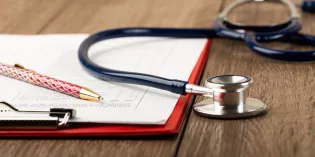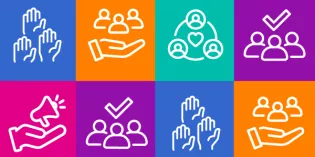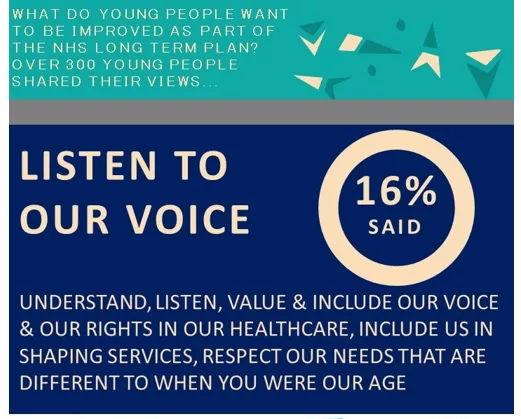- What do children and young people say?
- Overview and teaching resource
- How a paediatrician uses this domain in their everyday practice
- Case study 1 - Ways to communicate with the anxious patient when leading a consultation
- Case study 2 - Breaking bad news in the emergency department
- Case study 3 - Contacting the consultant on call overnight
- Downloads
These resources are related to one curriculum domain: 2 - Communication.
What do children and young people say?
We asked what good communication with services means - here's some of what they said:
- It would be good if we could email or message you our questions before the appointment in case we forget or aren’t brave enough to ask
- I want to feel that I understand my doctor and what he is saying, so that I don’t have to ask mum afterwards
- Communication is about building up trust, it’s nice when the doctor knows I like cadets and asks me at the start. It makes me feel comfortable.
Young people also told us what they wanted to see in the NHS Long Term Plan...
Download CYP voices flyer below
Overview and teaching resource
Our presentation explains the communication domain in more detail and can be used as an overview or for a teaching session.
Download teaching presentation below
How a paediatrician uses this domain in their everyday practice
It's a vital part of my work, important in the assessment of children and in being able to give information to families in a way that's easy to understand for them
Dr Janice Bothwell, Community Paediatrician at Belfast Trust, explains the importance of good communication for all paediatricians - with patients, families and colleagues - and gives her helpful hints.
Dr Julie-Ann Maney from Royal Belfast Hospital for Sick Children, describes how effective communication is important across a range of several paediatric roles.
Julie Ann Collins a trainee in Northern Ireland demonstrates an effective paediatric handover using essential communication skills.
Next, our case studies give examples of evidence that could be used to demonstrate contribution towards the domain learning outcome.
Case study 1 - Ways to communicate with the anxious patient when leading a consultation
I acknowledged his fears and anxieties, reassured him that I was there to help
Setting: General Paediatric Outpatients
How did the opportunity arise?
Leading a consult with a patient in outpatient clinic with medical complaints who has autism and is displaying challenging behaviours
What happened?
An adolescent male with autism and a fear of hospitals was brought by his parents to paediatric outpatients following a GP referral for abdominal pain and altered bowel habit. (He was asked if he would like his parents to leave the room for the initial discussion but they were welcome to stay with his permission).
He had seen a paediatrician privately regarding this several months prior who had performed blood and stool work-up and referred him to a paediatric surgeon, whom he was due to see later that day. The challenge involved was two-fold: navigating the consultation; and addressing his parents’ frustrations and concerns.
The consultation was difficult to initiate as the child was very upset from the start and was pleading with his parents to leave. He continued to be upset when I asked any questions and became angry when his parents answered for him. I acknowledged his fears and anxieties, reassured him that I was there to help and explained what I was going to ask and why. I used simple language in a calm manner and showed empathy and compassion.
He finally felt able to communicate his symptoms and we also had built enough rapport between us to allow a brief yet effective examination of his abdomen. I addressed each investigation that had been carried out previously, explained the results and reassured that IBD was extremely unlikely (which was his parents’ main concern). I also wrote a letter explaining our consultation and gave it to them for their paediatric surgeon. The patient left calmer than on arrival and his parents reassured.
How did this support your development?
The outpatient consult of a child can be challenging for a number of reasons and behavioural issues have the potential to disrupt the review, ultimately negatively impacting on the child’s health. In actively building upon interpersonal and communication skills and mindfully using them in such situations, you can tackle issues including fear, anxiety and stress in both the patient and parent to allow for improved clinical assessments.
Younger patients with developmental concerns or challenging behaviours are often assessed in the child development clinic setting. This is a useful opportunity to gain the perspective of experienced physiotherapists, occupational therapists, speech therapists and educational psychologists through interprofessional communication and they can often offer advice about approach to communication with children with difficulties. As a senior trainee perhaps you could lead the multi-disciplinary team meeting to further develop your communication skills.
Any practical tips?
Always approach a challenging consultation by gaining an appreciation for how both the patient and parent are feeling through their words and behaviour. I find it helps to verbally acknowledge that they are anxious to be able to proceed with the consult on medical issues.
Give ample time for the patient and parent to speak and engage with their answers, allowing them to guide the flow of the conversation. Listen carefully and check understanding. Show empathy and always remember to smile. Play specialists can also be a great resource for particularly challenging patients especially if the child’s behaviour makes it difficult to have a conversation with the parents.
Case study 2 - Breaking bad news in the emergency department
...an important time to demonstrate effective listening and non-verbal communication as you respond appropriately to the child and family’s emotions
Setting: Paediatric Emergency department
How did the opportunity arise?
You are the registrar working in a paediatric emergency department (ED). You see a six-year old boy with his mother who has presented with a two-week history of occipital headaches. The headaches are worse in the morning and associated with vomiting and nausea. Examination is unremarkable. As part of the work up in ED you arrange a CT brain. The patient’s mother is surprised that a scan is required and at this stage you explain that it is important to rule out an intracranial cause for his symptoms.
What happened?
Unfortunately the CT scan shows a large cerebellar mass and acute obstructive hydrocephalus. After discussion with radiology and neurosurgical teams, you and the consultant on duty arrange to speak to the mother. In preparation for the conversation, you ask one of the nursing staff and the play therapist to look after the patient so that you can talk to mum in a quiet room away from the main clinical floor.
You take the lead in the conversation as you have established a rapport with the family and the consultant supports you. You open the conversation by gaining mum’s understanding of the situation. You explain the results of the scan, taking your time for her to digest the information and to ask questions. You explain that her son will be admitted to the ward, commenced on steroid medication and will have an MRI later that afternoon. You tell her that she will meet the neurosurgical team shortly and that they will be able to give her more information.
How did this support your development?
Such a scenario is challenging, particularly in the ED setting as the diagnosis can be very unexpected for the family. By taking an empathetic and honest approach during a time that is distressing for a child and their family/carers we aim to deliver information clearly and sensitively, ensuring the patient and family understand and feel supported.
It is also an important time to demonstrate effective listening and non-verbal communication as you respond appropriately to the child and family’s emotions. This case highlights the challenges associated with delivering difficult news to a family in the busy, dynamic ED setting and the importance of considering the setting and environment very carefully.
Any practical tips?
In preparation for breaking bad news, try to gather as much information as possible, including the likely next steps of management. This may involve liaising with other specialty teams or healthcare professionals. Have the conversation in a quiet space where you won’t be interrupted, bleep free if possible. Try to gauge the patient’s and family’s perception of the situation. Avoid medical jargon and explain the information clearly without using euphemisms that may be misinterpreted. Allow plenty of time for questions, as well as silence as information is assimilated. Remember to debrief and reflect on these difficult scenarios afterwards with the team.
Case study 3 - Contacting the consultant on call overnight
...think of what you are going to say to ensure information is communicated effectively
Setting: Paediatric on-call rota
How did the opportunity arise?
You are the paediatric ST1 working the night shift at a busy district general hospital. You have been called to the ward to assess a newly admitted child who has become acutely unwell after receiving antibiotics. After assessing the child, it is clear they are in anaphylaxis. You initiate the appropriate treatment and a nursing colleague informs your registrar.
Your registrar arrives and after assessing the patient, asks you to contact the consultant on call to attend. The registrar is concerned the patient may need to be transferred to Paediatric Intensive Care Unit (PICU) as they are currently still unstable. It is 02:00 and the consultant is on call from home.
What happened?
You are aware it is 02:00 and the consultant will be in bed asleep. This needs to be taken in to consideration when making the phone call. The clinical situation is serious and will require the consultant to make their way to the hospital immediately.
It is important to think of what you are going to say to ensure information is communicated effectively. The phone call should begin with introducing yourself and use of crucial language: “My name is John Smith and I am the paediatric ST1 in DGH. I am calling to inform you we have an acutely unwell patient on the ward with anaphylaxis. Treatment has been given and the registrar is in attendance - however, we are concerned this child may need to be transferred to PICU as they remain unstable. We would like you to come to the hospital as soon as possible please.”
At this point, it is likely the consultant will agree to come in and give you an estimation of how long they will be. It is also possible they will give instructions for interventions in the meantime. It is important to listen carefully to these instructions and ask them to repeat anything you have not heard correctly.
How did this support your development?
Scenarios requiring the consultant to be called overnight are not uncommon in paediatrics. Often it is the senior colleague who makes the phone call if they are able; however, as a junior colleague, it may be up to you to have this conversation.
It is essential to have effective and efficient communication at all times in medicine, but this becomes even more important during overnight shifts. Everyone takes a while to register information when they have been woken up from a sleep. This is why it is even more important to use critical language that will alert your colleague to the seriousness of the situation. Brief introduction, the clinical situation, treatment being commenced and what you would like are the key components. Communication tools such as SBAR (Situation, Background, Assessment, Recommendation) can be helpful in these situations.
Any practical tips?
In paediatrics, the consultant on call usually attends the handover meeting the morning before your next nightshift. It can be useful to identify this consultant so you aware who you may need to contact.
It is also useful to introduce yourself as the night ST1, particularly if you have not met the consultant before. This makes phone calls easier as both parties will be able to quickly work out who they are talking to in a time critical situation. If you have not been introduced to the consultant, it is useful to ask the long day team who is on call and ensure you have the correct contact details.
Writing contact numbers on handover sheets, if not already there, is another useful tip to speed up the process of making the phone call.
Special thanks and acknowledgement to Julie-Ann Collins and Gail Davison with support from Dougal Hargreaves and Jessie McCulloch. Also to all who contributed in providing the content for this communication domain.











